
April 2022 • DALLAS MEDICAL JOURNAL | 3
ment? OSHA? The Department of HHS?
The CDC? The governor of a state?
Your local county? The mayor of a city?
A school board? And while federal
and state laws exist that presumably
answer this question, we witnessed
many legal battles over who or what
entity had the authority to enact
public health measures. We witnessed
controversy regarding public health
measures, including lockdowns and
business closures, social distancing,
mask wearing and vaccine mandates.
Given the acrimony and legal battles
we’ve seen over the past two years, I
suggest that this issue is not as clearcut
as we thought. While I don’t have
the answer to that question, I do know
for certain that I’m glad that I wasn’t
the County Commissioner during this
time – Judge Clay Jenkins, a dedicated
public servant, had a tough job.
3. Future Pandemics: Unfortunately, zoonotic
viruses are probably here to stay,
and we probably haven’t seen our last
outbreak of a zoonotic virus. What can
we do to prepare for the future?
a. Emergency Command Center: I
had the opportunity to hear Dr.
Trish Perl being interviewed in an
educational format for the Dallas
Assembly, and one of her suggestions
regarding pandemic organization
was to form a county-wide
command center that could
coordinate eff orts between federal
and state assistance and local
hospitals. If resources needed to
be rationed, the Command Center
could potentially coordinate care,
so if one hospital lacked a monoclonal
antibody that was available
at another health system, the patient
could be referred or “diverted”
to the other system. I hope that
during our post hoc analysis, the
Dallas County Health and Human
Services Department and other
county stakeholders consider such
a recommendation.
b. Mass Critical Care Guidelines: An
algorithm or guidance on how to
triage or ration limited resources in
the face of excess demand. One
ventilator and two patients in need:
the MCCG provides a guide to
determine the most judicious use
of resources based on probability
of survival. While some communities
experienced this during the
pandemic, and while Dallas County
came close, we never had been
faced with this issue. But if we were
ever faced with such an event, who
should have the authority to enact
critical mass guidelines?
4. Pandemic Politics: One of the issues
that has saddened me is the politics
of medicine and science during the
pandemic. Politics has, and always will
be, part of all professions in our society.
There were too many times during the
pandemic that we witnessed political
science instead of medical science.
There is one thing that I can state with
100 percent confi dence regarding political
versus medical science: the virus
didn’t care which political party was in
offi ce as the virus waged its campaign
of death and destruction in a truly
nonpartisan fashion.
5. Trust in Science: Scientifi c innovation
has benefi ted everyone in society.
Medical science and pharmaceutical
innovation have brought forth prolonged
life expectancy and improved
quality of life. Scientifi c innovation with
a vaccine that was invented within
a year saved thousands of lives. The
scientifi c method is a basic premise
that is taught to our sixth and seventh
graders. And while collectively we are
all generally pro-science, we have
witnessed increasing lack of trust in
science over the past two years. This
topic could be discussed for hours,
but I would like reference an opinion
of Dr. Lauren Fine published in the
DMN (1/22/2022), entitled Resolve to
Cultivate Intellectual Humility: “Leave
your echo chamber and listen to other
points of view. When did we become
more interested in hearing ourselves
than in hearing others?” Although trust
in science was not the main point of
her opinion piece, I think it applies to
this topic. Arrogance and hubris have
no role in medical science. While medicine
is a science, it is also an art.
6. Masking: Several times during the
pandemic, I was asked to sign letters
or petitions supporting the use of mask
wearing. I must confess that I felt a bit
unqualifi ed to sign such a document
because I didn’t really know the data
behind masking. In fact, I had never
ever read a mask study. I tried to recall
what I learned about masks in medical
school, and I can summarize this in
two sentences. First, if a patient with
TB presented to the ER/hospital, both
the patient and hospital staff were
supposed to wear a “respirator,” which
at the time was a blue semi-rigid mask.
Second, during my surgery rotations,
we of course wore surgical masks,
primarily and presumably to prevent
infection in a surgical wound.
We are often told that we should never
discuss politics, religion or reproduction. As a
reproductive endocrinologist and infertility
specialist, I discuss reproduction on a daily
basis, so I’d like to skip that one. Additionally,
what I have learned about religion as a
fertility specialist over the past 31 years is that
every major religion has both conservative
and liberal groups of thought. Every single
one! So, I’m going to skip the topic of religion
as well. That leaves politics, and I would like to
discuss politics – specifi cally, politics and the